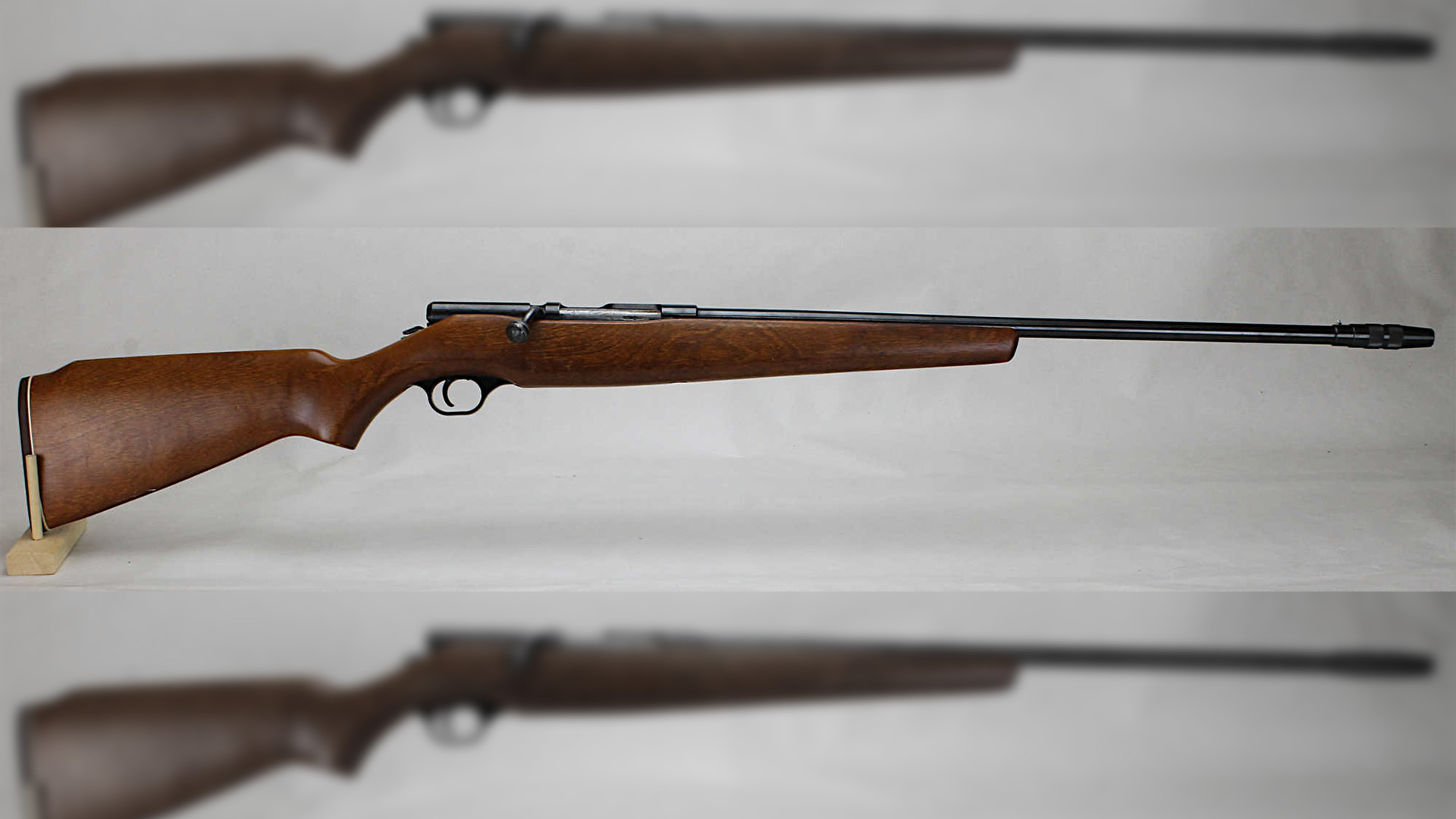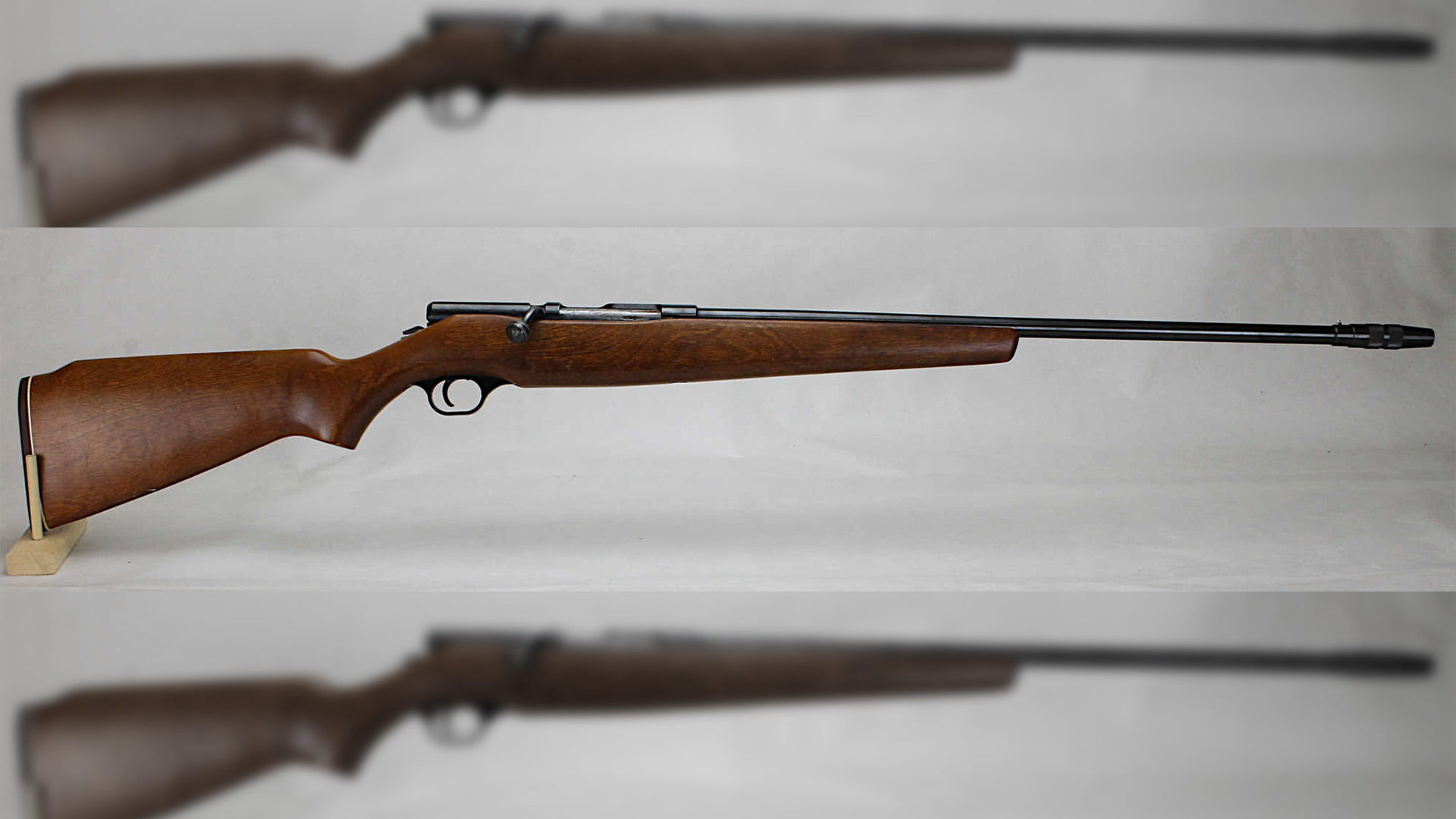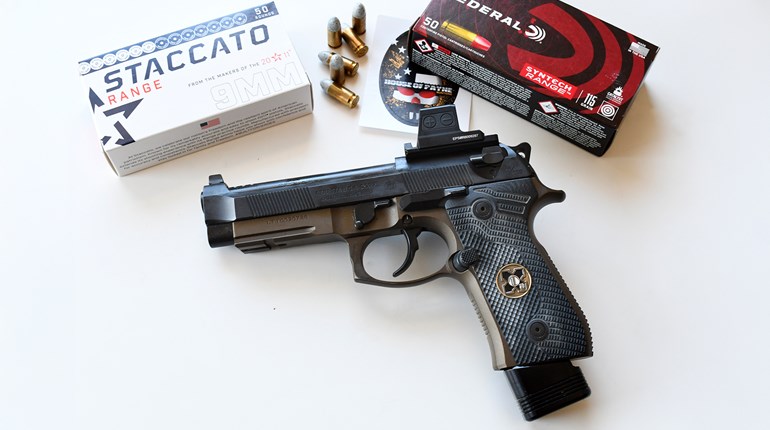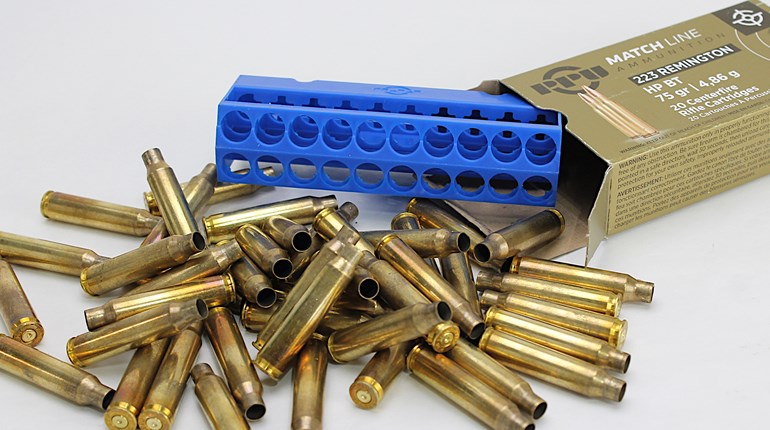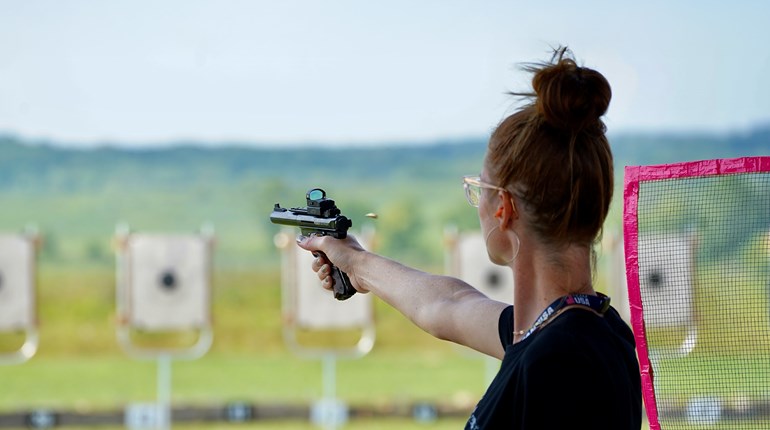
Depending on the game, rifle shooters sometimes need heavy guns and heavy barrels, which offer increased precision. Where movement and speed are major components of competition, lighter guns and barrels are advantageous, but precision is still the name of the game. For Ruger 10/22 shooters of rapid-fire games, Tandemkross can shave rifle weight—reducing time and raising scores—with its innovative Spitfire barrel.
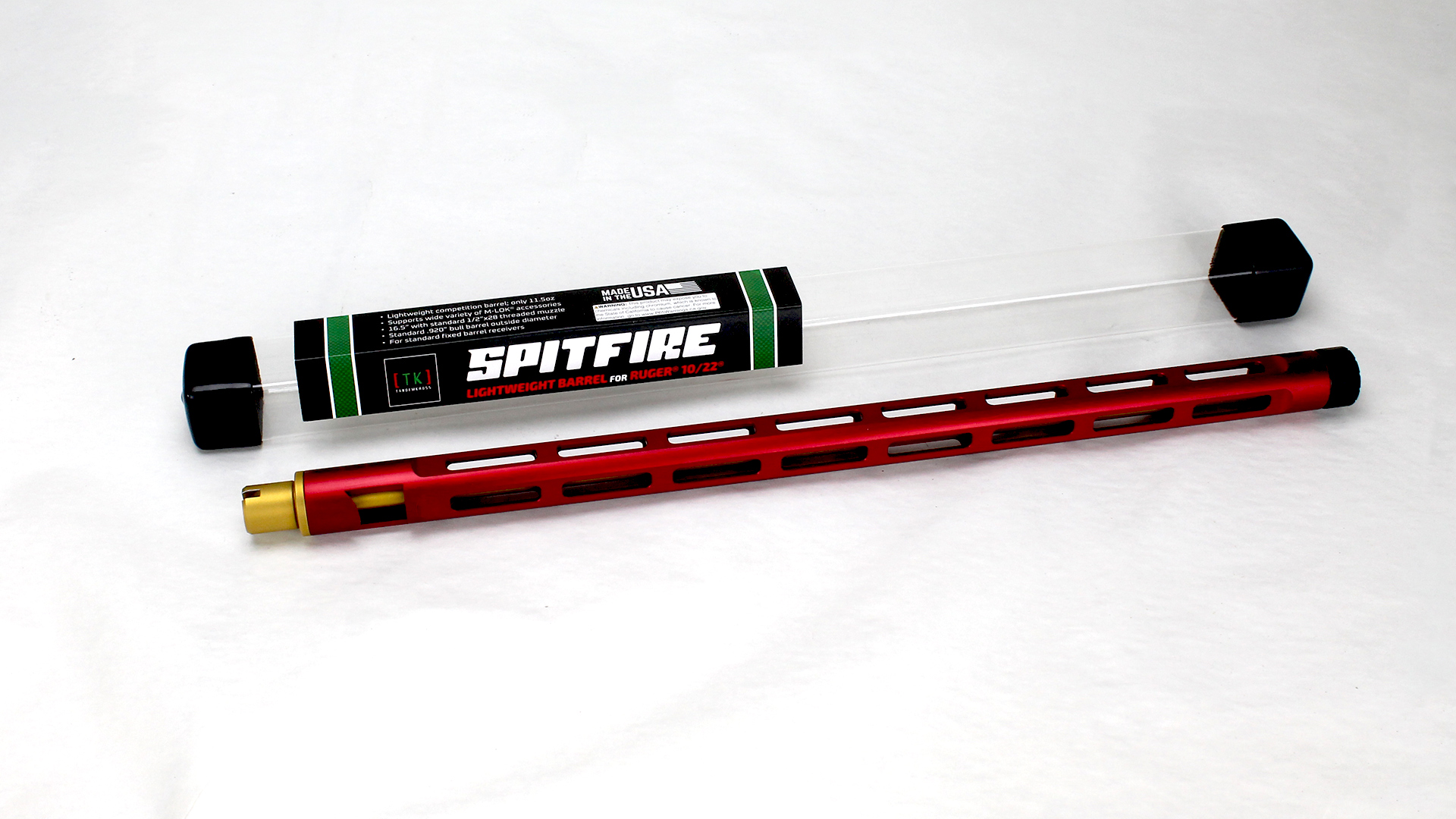
Tandemkross’s Spitfire is an assembly comprised of a 16-inch, pencil-thin stainless-steel barrel surrounded by an aluminum shroud. The shroud’s function is to “tension” the barrel to prevent barrel heating from warping the barrel and causing shots to wander away from point of aim. The tensioning support of the shroud is the heart of Spitfire’s comparative weightlessness, as it dispenses with the need of a heavyweight bull barrel.
The shroud physically contacts the barrel only at the breech and muzzle ends. The breech end of the barrel has a square shoulder milled into it to fit snugly against the square interior walls of the shroud; this prevents independent rotational movement of barrel and shroud when Belleville conical spring washers and a tensioning nut at the muzzle end are factory tightened to apply a pulling force on the shroud. Tandemkross cautions users to never adjust or remove the tensioning nut, as doing so can affect the assembly’s rigidity and degrade accuracy.
M-LOK cuts—32 of them, numbering eight on each of the shroud’s four sides—that allow attachment of accessories, also provide considerable venting for air circulation to cool the slim barrel.
RELIABILITY FIRST
Manufacturers and shooters tend to avoid pairing semi-automatic .22s with match chambers, which have tight tolerances and are short-throated to allow forcefully seating bullets directly into the rifling for best precision. (A simple method to check for a match chamber is to extract an unfired .22 Long Rifle round from a chamber and see whether the rifling engraved the lead bullet.) Match chambers can cause feeding and extraction stoppages (of unfired cartridges) in semi-automatics, so match chambers are instead found on bolt-action and single-shot precision .22 rifles in which chambering and extracting cartridges is done manually. A Bentz chamber for semi-automatics is essentially a mid-way compromise between a match chamber and a chamber of standard sporting SAAMI specification, designed to eliminate those feeding and extraction problems, but the Bentz chamber can be fussy about ammo choices, working with some ammunition but not others. Siding with reliability, Tandemkross elected to ream Spitfire barrels with standard SAAMI chambers.
“After lots of user feedback and a few years of internal testing and evaluation, we’ve determined that the improved accuracy a tighter Bentz chamber can offer isn’t worth the potential trade-off with reliable cycling in semi-autos—especially paired with the wide range of tolerance and quality levels for ammo,” Tandemkross Sales and Marketing Manager Alex Whiteside said in an email exchange. “Being primarily focused on speed-based competition and recreational plinking, we decided the higher priority needed to be placed on guaranteed feeding and cycling. That said, I think you’ll find the accuracy of the barrel to still be quite exceptional for its extremely thin profile and extreme weight reductions.”
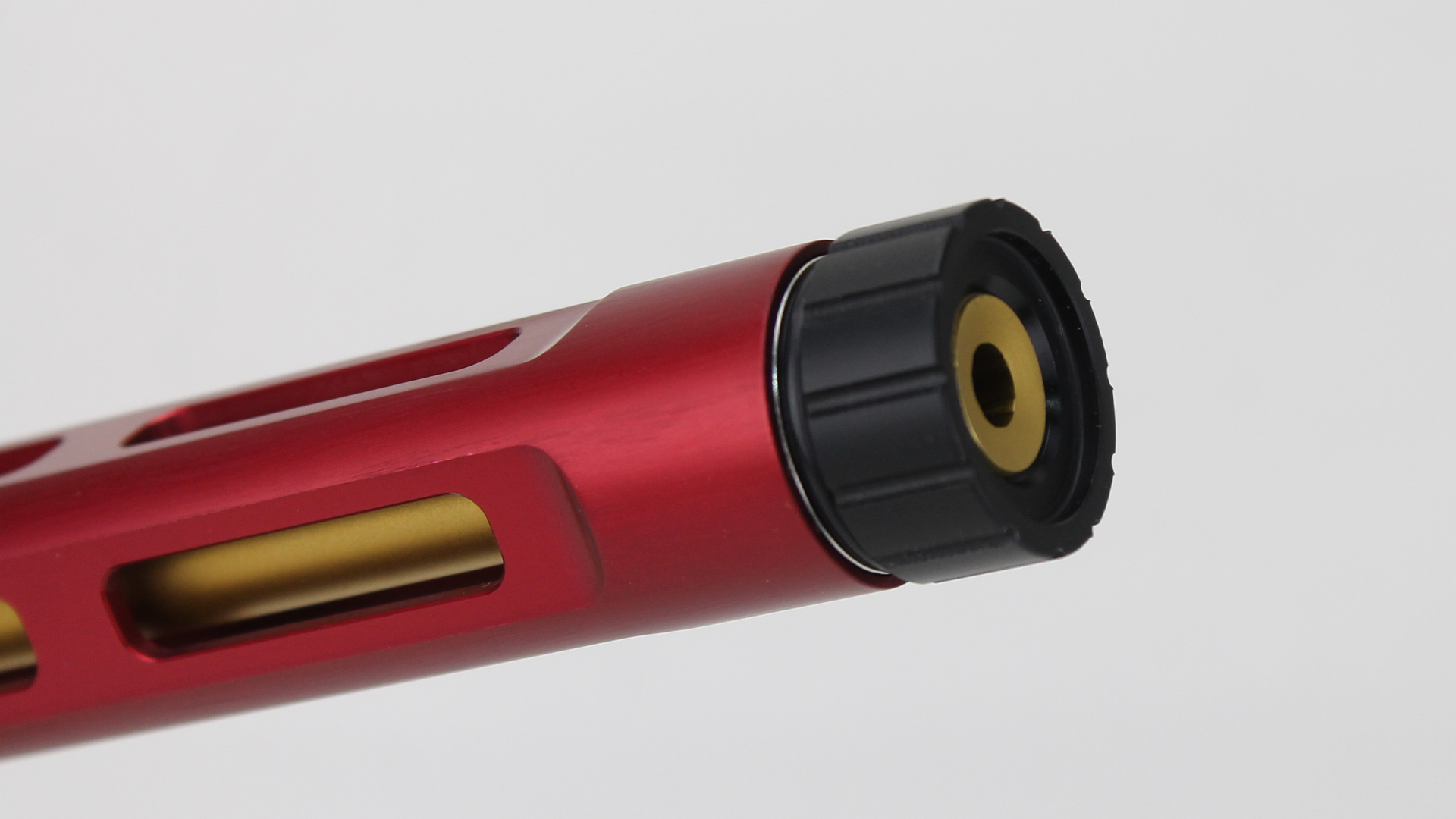
At its other end, the Spitfire sports a muzzle threaded 1/2x28 to take a suppressor, compensator or muzzle brake. The factory installed aluminum thread protector has a recessed face that protects the muzzle in the manner of a target crown. A rubber O-ring serves as a crush washer to ensure the thread protector does not move during firing. I can say from experience that a loose thread protector can throw bullet impacts out of a group, and the rubber O-ring suffices to secure the thread protector against the low recoil and muzzle blast of the .22 Long Rifle cartridge.
GORILLA-LESS INSTALLATION
To evaluate the Spitfire, I pulled the barrel from a factory new Ruger 10/22 Model 1151, which features a thick “Black Satin” finish that Ruger does not identify but that appears very much like the baked-on “Suncorite” finish the British applied to some of their SMLE rifles. Tandemkross says, “Due to slight variances between receivers and receiver finishes, some minor fitting may be required.” At first it appeared I’d have to remove the thick finish where the Spitfire’s shroud contacts the barrel ledge on the 10/22’s receiver—the tolerance is that tight. Some careful try-fitting showed removing the finish wasn’t going to be necessary.
Removing the factory barrel is as simple as using hex wrenches to first remove the stock by turning out the screw in front of the magazine well, and then the two screws from the V-block fastening barrel and receiver together. If the barrel and receiver will not separate by pulling them part by hand, grip the barrel in one hand and drive the receiver off the barrel by tapping on the barrel ledge with a rubber mallet.

For this barrel-mounting operation, I left the bolt in the 10/22’s receiver so that I could visually align the extractor notch in the barrel with the extractor’s edge on the bolt. Once started into the receiver, the tight fit of the barrel shank in the receiver prevents any twisting of the barrel, so the alignment must be spot-on before applying the rubber mallet to the back end of the receiver to seat it on the barrel. It isn’t necessary to wail away with the mallet like an enraged gorilla; if moderately firm taps aren’t joining the barrel and receiver, keep in mind the aforementioned, “minor fitting may be required.”
Because the Spitfire barrel has the larger .920-inch diameter of a bull barrel, it would not drop back into the factory synthetic stock made for the original slim sporter weight barrel. Instead, I installed the Spitfire barrel-receiver-trigger group assembly in a fully adjustable Luth AR MCA-22 stock and mounted a Mueller 4.5-14X scope on the Ruger factory rail. (No, the scope is not suitable for up-close, fast-shooting games, but the high magnification offered the Spitfire its best opportunity for precision by eliminating shooter sighting errors.)
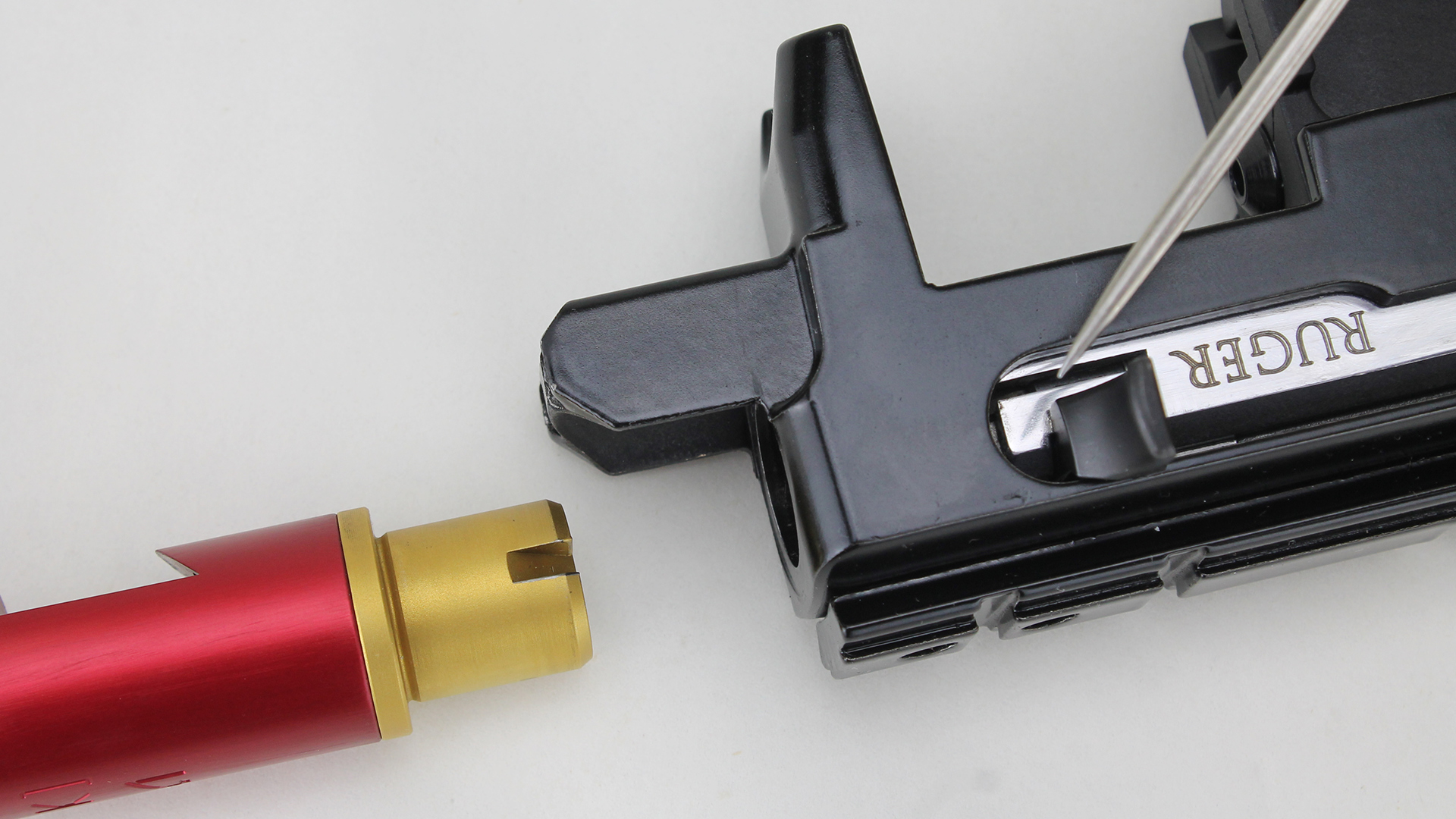
GOLD COMPENSATION
Though many shooters consider rifles chambered in .22 Long Rifle to be recoilless, the cartridge does indeed impart some recoil, more noticeably so when the rifle is deliberately lightened as the one here with the Spitfire barrel. While such recoil is of no concern to shooter comfort, it does move the sights off the target and adds precious time needed to reacquire the target when competing against the clock.
Enter the Tandemkross Game Changer Pro Compensator—gold color, of course, to match the Spitfire barrel. Indicating 2.85 ounces on a digital postal scale, the Pro Compensator carries most of its bulk on the bottom. Four large ports on the top jet propellant gases upward to push the compensator downward to counteract muzzle rise. The ports are angled 45 degrees to vent gases away from the shooter’s line of sight. Like every made-in-America Tandemkross accessory that I’ve examined, the compensator is nicely machined and finished.
Tandemkross designed the compensator with wrench flats (why doesn’t everybody do that?) and, again, a rubber O-ring serves as a crush washer. The O-ring appears to be identical with the one that came installed with the thread protector, so I used the latter to save wear on the former and keep as a spare. A drop or two of blue thread locker added some confidence the compensator wasn’t going anywhere.
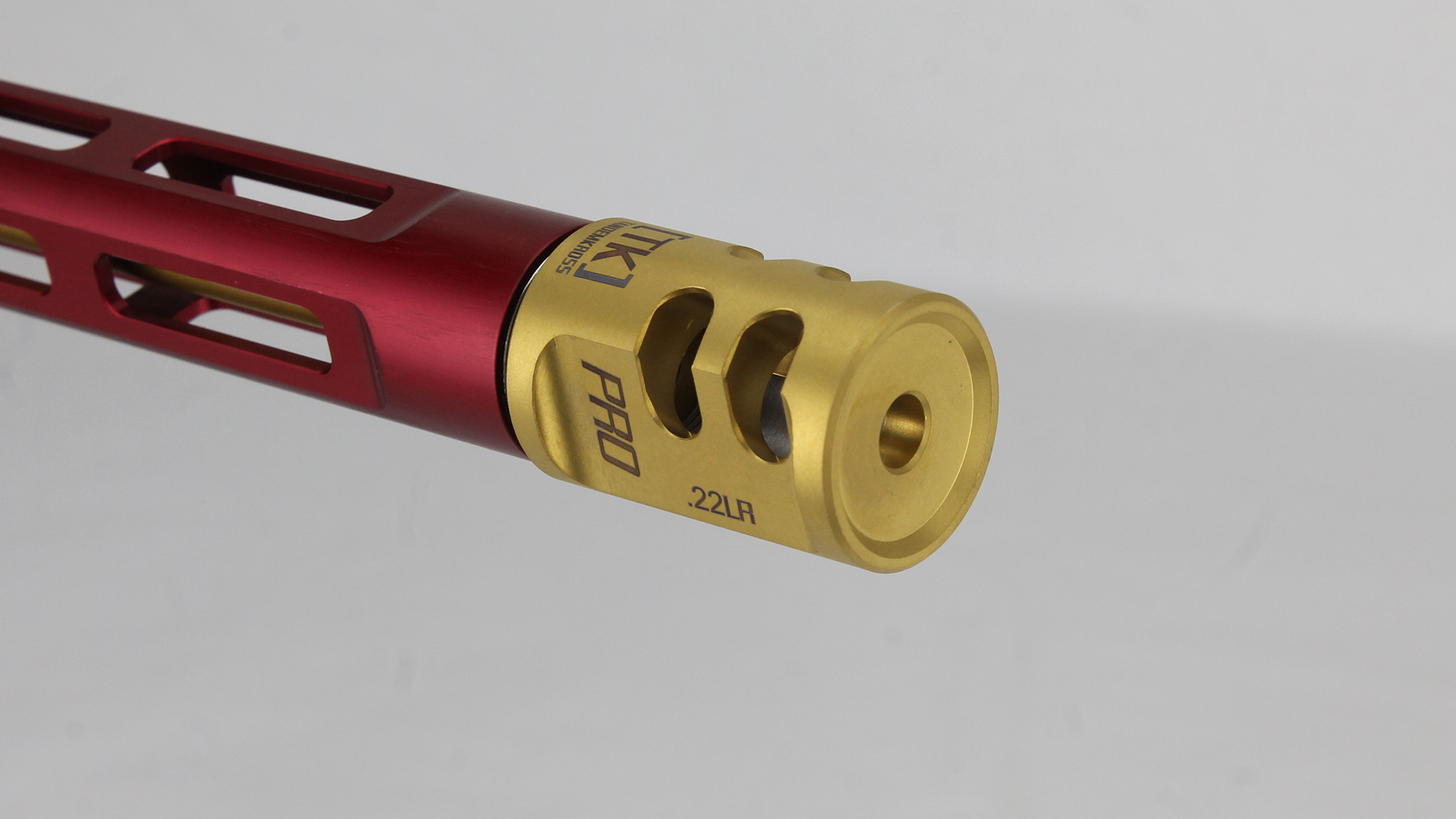
So, how much weight did the Tandemkross Spitfire shave off the 10/22? The pull-off factory barrel weighs 1.91 pounds, the Spitfire 0.722 pounds, for a significant weight savings. The Spitfire and Pro compensator, at a combined 0.908 pounds, still weighs less than half the factory barrel alone.
HEAT TEST
At the shooting bench, I first slow-fired 20 rounds to foul the barrel, then shot three five-shot groups at 50 yards with Norma Match ammunition to establish a baseline for the Spitfire’s precision. Cadence was one shot about every 10 seconds. Next came 20 rounds of unaimed rapid fire to heat the barrel, followed immediately by repeating the three five-shot groups. The first three groups (the baseline) averaged 2.79 inches, and the second 3.01 inches—no appreciable difference attributable to barrel heating.
MADE FOR DIY
You’ve noted by now that Tandemkross accessories are made for the DIYer possessed of ordinary mechanical aptitude. Ruger’s 10/22 is modular, simple to understand and requires no specialized tools for installing the Tandemkross accessories (though the company does offer some 10/22-specific tools that make disassembly and reassembly easier.
Tandemkross parts and accessories do not come with printed instructions. Instead, detailed installation instructions for Tandemkross products can be found at the company website as PDFs. Instructional videos also appear on the web pages that describe each product. For example, for a Spitfire installation video, click on the Spitfire offering in the online catalog at the Tandemkross website.
Spitfire barrels are available directly from Tandemkross for $299.99 to $334.99, depending upon color combinations; Pro compensators go for $59.99 to $74.99. Tandemkross manufactures a wide selection of accessories for .22 Long Rifle pistols and rifles, all designed to upgrade performance for the competitor and spiff up a favorite plinker. If .22 is your game, see what the Tandemkross website has for you at tandemkross.com.









